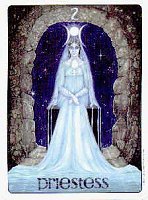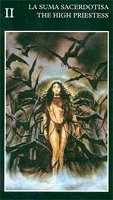|
Tarot Reflections |
August 1 , 2004 |
| Shadow Aspects of The High Priestess Sandra Thomson, CTGM |
||||||||
|
Tarot Town News: Morning Edition
In the daylight, we see clearly that The High Priestess calls upon us to turn inward and to recognize that ours is, indeed, an inner journey. She is a mysterious woman, hinting at the revelation and understanding of life's hidden secrets through the feminine, who is their guardian. Tarot Tattler Tales: Midnight Edition
Through her dark vision, she already knows that The Fool's next stop is to take respite in the Passion Place garden of her nearby neighbor, The Empress, and her foremost desire is to teach him how to seduce the lady of the house. Because she is related to the prophet-receiving ladies of Apollos's Oracle at Delphi, it makes you wonder how friendly she was with the gorgeous Apollo. That, however, is the story of The High Priestess's journey; and she never kisses and tells, except when she feels like it. When The High Priestess works her dark magic, we, and The Fool, are caught in her net of intrigue and fatally robbed of our self-confidence, and our ability to trust our intuition. Clearly The High Priestess has lots of underworld goodies to offer, and it is part of her task to help us acknowledge the clutter in the basement of our psyches. |
|||||||
|
Mythological Villainy He was seldom at home, always on the move. A real party animal, except that wherever he went, whatever parties he attended, he left conflict and madness in his wake, so he wasn't invited to stay around for very long. As is typical of a heavy drinker, he had difficulty committing to relationships and obligations; he was incredibly moody. He may well have been a bi-polar personality in that he could, and did, shift moods at the slightest instigation. The good news for Dionysus was that he was perpetually surrounded by women enraptured of him. They loved to show how much they worshipped him by drinking until they were irrational. Their celebration was called the "Orgia," from which the word "orgy" is derived. It is Isis who gives birth to Horus, the son of Osiris. Ultimately Horus will kill his uncle Set for murdering his father. Never underestimate the lengths to which a dark widow will go to wreak revenge. The hieroglyph of Isis's name, and the symbol often seen covering her head, resembled a throne; and she was originally thought to be the personification of the throne from which were born the kings of Egypt. 1 Being the mother goddess of Egypt also joins Isis with Major Arcana III, The Empress. One of Isis's symbols was the mu'at, or "foundation of the throne," which also represented Maat, "the motherhood principle called Right, Justice (Major Arcana XI), Truth, or the all-seeing Eye." 2 Right away we see that Isis influences the quartenary of The High Priestess, the Empress, Justice, and The Moon. When The Fool realizes that he will have to encounter four strong women, who are equally powerful, and probably not a little jealous of each other, we can only wonder how long it will take him to finish his drink and wish he could turn in his round-trip ticket on The Nightmare Express. The Dark Year If The High Priestess is your year card, this will be the year where your shadow aspects will encourage you to spend a lot of time taking things quite literally rather than looking at their symbolic aspects. Cycles and patterns in your life will have little meaning, and you are not at all interested in identifying the influence of repeating patterns or cycles alive in your reactions. Just react, and don't think about it. The Darkest of the Dark The High Priestess's two pillars, one dark, one light, represent the initiation process, that of learning to mediate between the upper and lower regions of our psyches. This only happens when we join The Fool on The Nightmare Express and learn to recognize and accept the shadow aspects of our personalities. Until then, we remain "Strangers on a Train." The High Priestess represents the "virgin" goddess, which is both an attitude and a physical state. When our dark High Priestess comes up for air, we have no interest in regarding ourselves as spiritual beings or in attempting to bring Spirit into our lives. We not wish to consider that any relationship can bring about any aspect of personal healing—in fact, we do not even perceive ourselves as needing "healed." Our strongest desire is to remain "an innocent" throughout life—the puer and the puella—the perpetual man-child or woman-child who refuses to grow emotionally. This is, in part, related to her association with Dionysus, who wished to remain always an eternal adolescent. We live in a culture which, at present, is heavily populated with people who think they know more than they actually do, believe they are wiser than they actually are, don't care a whit for the symbolic life, and emotionally are still teen-agers (if not younger). Is that not the communal shadow of the High Priestess? Personal Shadow Work When you work with shadow aspects of The High Priestess, consider:
References: 1. Leach, M., ed. and J. Friend, assoc. ed. Funk & Wagnalls Standard Dictionary of Folklore, Mythology, and Legend . San Francisco, Harper & Row, 1972. 2. Walker, B. G. The Woman's Encyclopedia of Myths and Secrets . San Francisco: Harper & Row, 1983, 454. High Priestess cards from the Rider Waite Tarot and Gill Tarot © U.S. Games, Black Tarot © Fournier |
||||||||
|
Subscribe to Tarot Reflections, and receive notification of each update! |
|
Request to be added to the list by sending email to TarotReflections-subscribe@yahoogroups.com! |
All articles remain the
property of their respective authors.
Tarot Reflections is a publication of the American Tarot Association
- Copyright (C) 2004
Questions or Comments? Contact Us.




 In the Rider-Waite-Smith deck, The High Priestess sits on a stone bench in front of a curtain bearing the images of palm trees and pomegranates. Several Greek myths connect the pomegranate with Dionysus (Bacchus), god of wine and drunken revelry. Although Dionysus was male, his characteristics also apply to the noir side of The High Priestess.
In the Rider-Waite-Smith deck, The High Priestess sits on a stone bench in front of a curtain bearing the images of palm trees and pomegranates. Several Greek myths connect the pomegranate with Dionysus (Bacchus), god of wine and drunken revelry. Although Dionysus was male, his characteristics also apply to the noir side of The High Priestess.